Earth's Changing Biomes
What Are Biomes?
Earth’s biosphere consists of five main types of biomes: aquatic, grassland, forest, desert, and tundra. These biomes can be further divided according to location, elevation, or other definitions. Biomes are generally defined by the types of vegetation, soil, climate, and wildlife within them. Note that a biome is different from an ecosystem. A biome is a specific geographic area notable for the species living there, while an ecosystem is defined as the interaction of living and nonliving things within an environment. Each biome can be home to several different ecosystems.
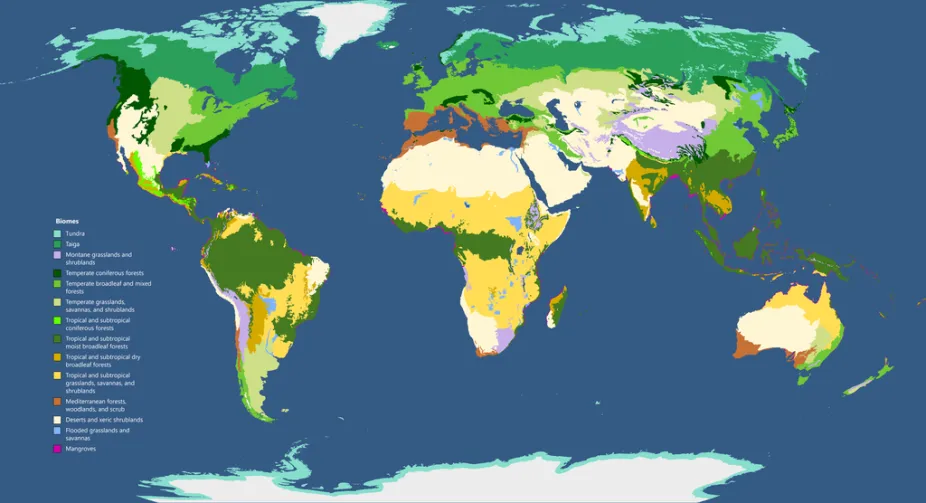
A map of biomes around the world shows the division of the main biome types (grassland, forest, desert, aquatic, and tundra) into smaller biogeographical units.
Creative Commons Terpsichores
Natural Changes Happen Over Long Timescales
Biomes can be affected by changes within the Earth system at both long and short timescales. The primary biome present in an area can change over time as the climate changes. Ten thousand years ago, parts of North Africa were green, lush landscapes with abundant trees and flowing rivers. Today, that region is part of the Sahara Desert, the world's largest desert. But how do these shifts happen, and over what timescales?
Natural processes happening all the time lead to some of these changes. Not all of the details of the mechanisms involved in forming the Sahara Desert are well understood, but scientists have found evidence that various influences, including drying associated with periods of glaciation, small wobbles of Earth’s axis, and variations in monsoon activity, have caused the Sahara to alternate between desert and savanna grassland in an approximately 20,000-year cycle. This cycle has swung the region’s dominant biome back and forth, from wetter to drier, for at least 2 million and up to 7 million years.
Other changes are caused by shorter-timeframe influences, such as human-caused global warming. In fact, more than 89% of the changes that we have seen within ecosystems and biomes today are consistent with a response to climate change. For example, small changes in temperature are enough to cause spring thaw to happen earlier and fall frost to come sooner, which changes the timing of the growing season for plants and trees. Over time, these types of shifts cause a region to become more favorable for certain plant or tree species than for others, which can alter the types of plants or trees present in an area. Already, the suitable habitats for certain tree species are moving northward and to higher elevations where temperatures are cooler. The suitable habitat for sugar maple, which is an economically important tree species, is expected to shrink within the northeastern U.S. as its preferred climate conditions shift north into Canada. Warmer temperatures can increase outbreaks of forest pests and pathogens, while at the same time, growing deer populations degrade forest understories. These stresses affect overall biodiversity, function, and resilience within a biome. Instead of timescales of thousands and millions of years, many of these changes have occurred in just a few decades.
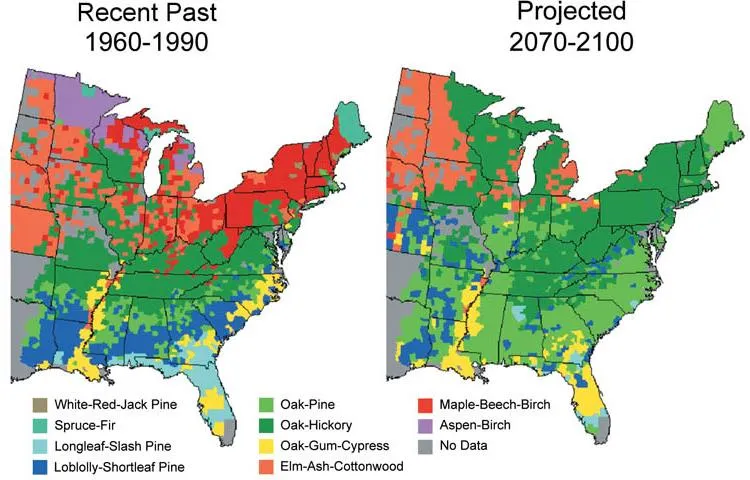
Already, scientists are observing changes in the habitats suitable for trees like maple, beech, or birch. Current projections suggest that the types of forests present in multiple parts of the U.S. will change significantly, even by the end of this century.
EPA
Early Humans Impacted Biomes Long Ago
Over time, many of Earth's biomes have been impacted by human activity, and these changes began to happen almost as soon as humans were around. For instance, hunting by early humans is thought to have contributed to the extinction of some megafauna, and the controlled burning of forests dramatically altered landscapes as long as 12,000 years ago. In the 1700s, prior to the Industrial Revolution, almost half the world was covered in wilderness, but current estimates indicate that just 23% of the area within land-based biomes and 13% of the area within marine biomes remains untouched by human industrialization.
Forest and Grassland Biomes Are Altered by Agriculture
Agriculture is a human activity having significant impacts across biomes as well as the whole Earth system. The entire food system — from production to consumption — accounts for about 25% of total greenhouse gas emissions into the atmosphere. Agricultural production has advanced to feed the world’s growing population, which quadrupled in size over the past century to just over 8 billion people in 2022.
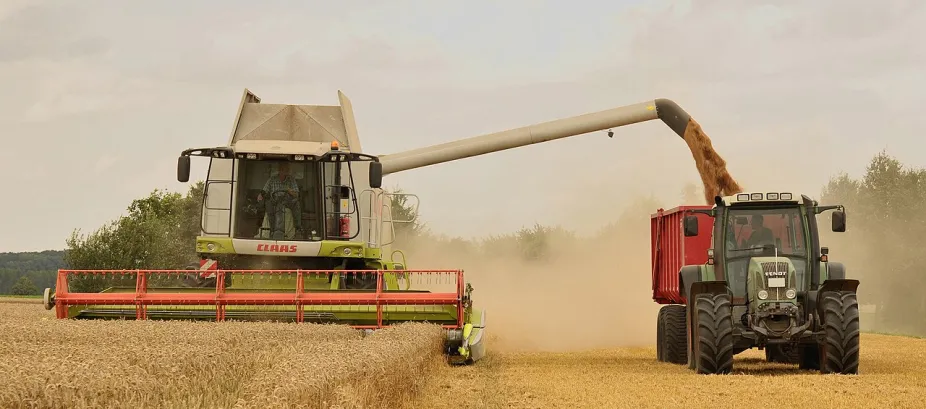
Agricultural production uses a significant percentage of Earth’s tillable land and can dramatically affect both biomes and ecosystems.
Creative Commons Michael Gäbler
Nearly half of all cultivated land on the planet is devoted to growing cereal crops — corn, wheat, rice, and other staple grains. Although many farmers and ranchers feel strongly about preserving the environment and growing crops in a sustainable way, some agriculturally driven land use changes end up harming or causing stress to other parts of the Earth system. For instance, cutting rainforests to make room for grazing cattle can shift the dominant biome from forest to grassland.
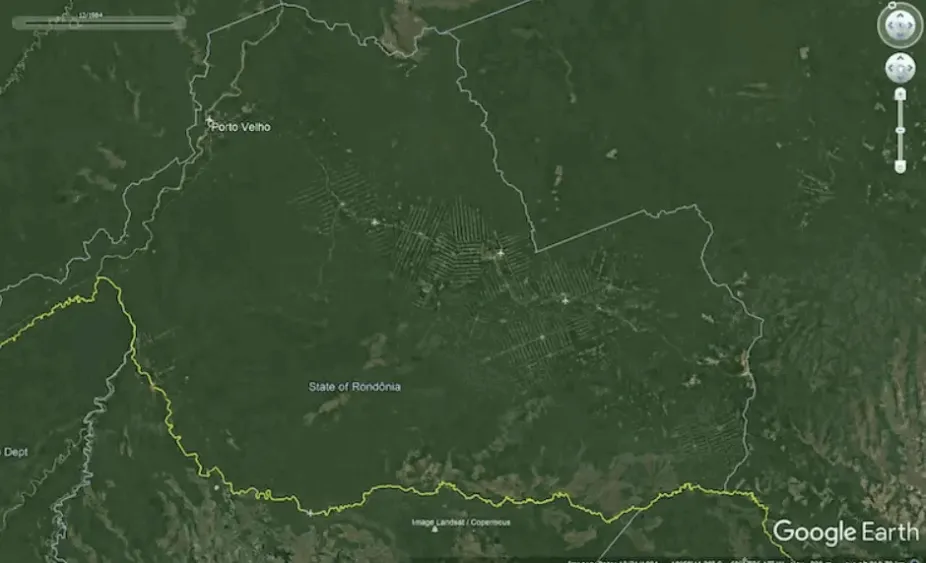
Comparing the first image (from 1984) with the second image (taken in 2016) shows that cleared areas and roads have replaced forest areas in the Amazon.
Google Earth
Even within an existing biome, monocropping and overfarming can alter soil properties, leading to longer-term changes in what can grow or not grow. And decreases in the amount of available water can dry out a biome, increasing desertification in areas previously dominated by grasslands, for example. Agriculture is currently estimated to account for 70% of freshwater use worldwide. But keeping a growing population fed may require an additional 15% more water by 2050, which threatens to deplete aquifers, river systems, and groundwater supplies.
Forests Are Experiencing Multiple Threats
Wildfire is another factor affecting Earth’s biomes, particularly the planet’s forests. Wildfires are a part of nature, but recent years have seen more fires, as well as larger fires, than in the past. The number and size of wildfires are increasing in part due to warmer, drier conditions that lengthen the fire season. Instead of fires typically occurring in the summer or fall, when fuels dry out, many places now experience wildfires at any time of year.
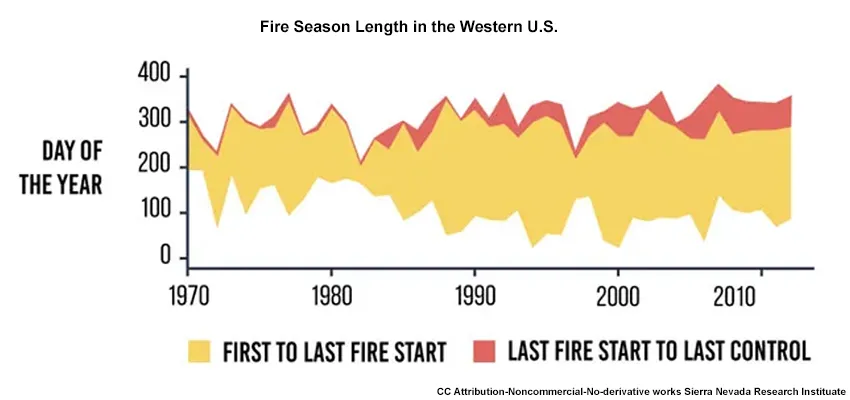
For the western U.S, the time from the first yearly fire start to the last fire control has exceeded 300 days per year every year since the early 2000s.
Creative Commons Sierra Nevada Research Institute
As our climate warms, the hotter and drier conditions contribute to the spread of insects like the mountain pine beetle, killing trees and providing fuel for wildfires to very quickly consume and spread. Warmer wintertime temperatures have already allowed pine beetles to spread and thrive across many parts of the U.S. Mountain West. These beetles have killed tens of thousands of trees, causing direct impacts on forests in many areas.
Related Links
Resource Links
- The Five Major Types of Biomes
- Putting the “Me” in Biome
- Green Sahara: African Humid Periods Paced by Earth's Orbital Changes
- Fourth National Climate Assessment Vol 1 (2018)
- Fourth National Climate Assessment Vol 2 (2018)
- Five Maps That Reveal the World’s Remaining Wilderness
- Environmental Impacts of Agricultural Modifications